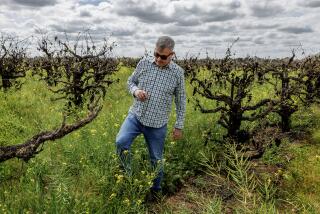Their goal: conquer
Quietly and with stunning speed the Australians have been invading the United States -- with wine. Following a detailed production and marketing plan, and taking dead aim at California’s place in the wine market, Australia is about to pass Italy as the No. 1 imported wine in America.
The Australians are leveraging their dramatically lower costs of production to catapult themselves forward at a time when American vintners are struggling to stay afloat in a worldwide glut of wine.
With 90% of the Australian imports to the U.S. priced between $6 and $11 a bottle, this segment of the wine business -- already the most competitive -- is turning into a slugfest. The stage is set for an old-fashioned price war as consumers face an overwhelming number of reasonably priced choices in table wine.
And this is just the beginning of Australia’s rise. Kroger Co. wine buyer Graham Lee, who oversees wine sales at 2,488 stores including Southern California’s Ralphs division, says that six months ago, his stores didn’t have an Australian wine section. But with Aussie wine sales in the U.S. growing by 50% a year, Lee says he is clearing out slower-selling California wines from Gallo and Fetzer to make room for hot brands like Australia’s Yellow Tail.
That’s a tidy bit of work for a country on the far side of the globe that until the 1970s specialized in low-class, high-alcohol wines and, even 10 years ago, exported only a trickle of its premium varietal wines to the U.S. What they lacked in posh pedigree and experience, the Australians have made up for in moxie, staking their future on an uncompromising premise: delivering better wine cheaper than California.It was a plan born of necessity by ambitious vintners eager to grow beyond what Australia’s small population of 19 million people could support.
With an all-for-one unity unheard of in the California wine country, Australian vintners locked arms with each other and the Australian government in the mid-1980s, determined to become major players in the world of wine.
In 1991, they set an audacious goal of increasing exports from $112 million to $622 million by 1998. Reaching that benchmark years early, their next plan called for $1.6 billion in export sales by 2025. Last year, Australia recorded $1.4 billion in wine exports.
“Unity has been our competitive advantage,” says Sam Tolley, chief executive of the Australian Wine and Brandy Corp., the government-industry organization responsible for the seemingly contradictory jobs of regulating and marketing Australian wine. “It’s a bit of a strange model,” Tolley says, but it’s not unusual in Australia. “The government has always encouraged exports.”
A group effort
That doesn’t mean plentiful government subsidies, he says. Rather, the companies came together and voted a tax on themselves to create a government organization to help them grow. As their needs have expanded, Tolley says wine companies have voted to increase those taxes.
Under the leadership of the Australian Wine and Brandy Corp., Australia’s vineyard land has more than doubled in the last 10 years. Instead of investing in more of the Semillion favored by Australian drinkers, the corporation encouraged growers to plant Chardonnay. The acreage devoted to Australian Shiraz, another grape the corporation believed would appeal to American drinkers, was increased.
The under-$10-a-bottle wine buyer was the target. In that price range, it was determined that red wines should deliver a mouthful of berries, fruity but not too sweet, and be blended for a consistent, even taste. The white wines should be light on the tannins with the bumps blended away.
Marketing Australian wine has always been a road show. From the earliest days in the mid-1980s when Rosemount was the only Australian brand available in the U.S., wine companies have gone town to town to peddle their wines to those willing to experiment with the unknown. That grass-roots approach continues today.
“The Australians offer good values across the board,” says wine industry consultant Jon Fredrikson. At every price point, he says, consumers are finding better quality Australian wines when compared to California’s.
Unlike American and European vintners, who believe a wine’s taste should reflect the place it is grown, the Australians are proud of their blends, says Kylie Hargreaves, Australia’s deputy consul general in Los Angeles. She and other Australians talk about their wine’s consistent, “smooth” qualities, flavors that don’t vary dramatically by vintage.
“People in the wine industry in Australia sat down with consumers and asked them what they like. And guess what? They like wines a bit sweeter and with less bite,” says Jim Watkins, the top U.S. executive with Australian-owned Beringer Blass Wine Estates.
“Words like ‘austere’ and ‘complex’ don’t even come up” when you talk to consumers, says Tom Burnet, president of the U.S. division of Southcorp, Australia’s largest wine company.
All of this reflects a fundamental difference between Australia and the U.S., say wine industry analysts. American vintners take themselves and their wine very seriously, largely selling wine through snob appeal. The Australians, who drink three times as much per capita as Americans, aren’t so precious about pulling a cork. “We don’t take ourselves too seriously,” says John Larchet, an Australian wine importer with offices in Melbourne and San Diego. “It is very common for us to say, ‘God, that’s a good drink.’ You’d never hear an American say that about wine.”
While California vintners were dismissing “value” wines, intent on pushing consumers into higher priced brands with bragging rights, as well as better profit margins, Australians have stepped in during the last five years with $7 and $8 wines, says Rich Cartiere, editor of Wine Market Report.
California winemakers finally are hearing the wake-up call and will rise to the challenge, says Cartiere. “The lesson has been to put the consumer first by delivering a delicious tasting wine people can drink today.” And the Australians are vulnerable. “Prices at the bottom always drop first,” says Cartiere, noting that Charles Shaw wine, which sells for $1.99 at Trader Joe’s, has undercut their “low-price” position.
The influx of new Australian brands only adds downward pressure on price.
“Southcorp has dominated Australian wines here,” says Kroger’s Lee, noting that the conglomerate’s Penfolds, Lindemans and Rosemount labels are among the biggest-selling Australian brands in the U.S. “As they fight to hold onto their market share against the new competition,” he says, “these wines are going to get even less expensive.”
In a price war, the Australians will have a key advantage: lower costs.
With a landmass equal to the United States but a New York state-size population, Australia has almost limitless space available in growing regions that reflect every type of wine growing climate and typography. And yet the average price of vineyard land is one-fifth the cost of better California acreage.
The lack of workers to hand-trim vines and hand-pick grapes, the standard way Americans tend their vineyards, forced money-saving mechanization early on. Australian vintners have invested heavily in mass production.
And then there is the exchange rate. For the last five years, the Australian dollar has traded for less than 65 cents against the American dollar.
“It’s really inexpensive to create a new Australian brand,” says Mark Evans, with Yalumba, Australia’s oldest family-run winery.
Pick a name that screams “Australia,” design a brightly colored label, buy bulk wine and blend it for the American palate then flood the U.S. market, says Evans. Though he distains the formula -- Yalumba sells higher priced wine that it markets in Australia as well as the U.S. -- it is precisely the story of Yellow Tail. And, while Yellow Tail fared poorly in a Los Angeles Times wine tasting, it is the fastest-growing wine brand in the world.
“We’re a buy-now, drink-now product,” says Yellow Tail winemaker John Soutter with Casella Estate Wines, a bulk wine grape grower in the Riverina region of New South Wales, a place a lot like California’s Central Valley.
When Casella launched the brand last year in a joint venture with New York City-based distributor W.J. Deutsch & Sons, Soutter believed they’d sell 25,000 cases. Instead, they sold 1.5 million cases -- without any advertising. In 2003, they expect to sell another 4 million cases of Yellow Tail wine.
“You have an industry that knows it needs to export to grow,” says Watkins, of Beringer Blass. His company distributes the Australian standard-bearer label Wolf Blass, and created Black Opal and Greg Norman Estates, brands that were initially sold only in America.
Foreign relations
Larchet, who handles dozens of higher priced labels from small, independent vineyards through his Australian Premium Wine Collection, has created his own label, Wishing Tree, blended from bulk Australian wine. He says he expects it to quickly become his biggest-selling wine. It sells for $8.99.
Savvy American wine companies are jumping on the Australian bandwagon, creating joint ventures that marry cost-effective Australian wine production with American distribution and marketing. Venturing abroad is nothing new for U.S. wine companies, which already own vineyards in Chile, parts of Europe and New Zealand.
While the Robert Mondavi Corp. has blamed inexpensive Australian imports for its slumping sales, in 2000, it also created a partnership with Southcorp’s Rosemount Estate to make Kirralaa wine, an Australian wine Mondavi is distributing in the U.S.
E. & J. Gallo, the second largest U.S. wine company, is behind the recent U.S. launch of $6.99 Black Swan Australian wine. Australia’s McGuigan Simeon Wines is producing and bottling the made-for-the-U.S. wine and Gallo is distributing it, supporting the new brand with a $20-million advertising blitz.
And U.S. spirits conglomerate Constellation Brands Inc. recently bought Australian wine giant BRL Hardy, creating the world’s largest wine company.
In fact, every major U.S. wine company is working on a business relationship with an Australian vintner.
“When you see American companies copying them,” says Kroger’s Lee, “You know the Australians are going to last.”
More to Read
Eat your way across L.A.
Get our weekly Tasting Notes newsletter for reviews, news and more.
You may occasionally receive promotional content from the Los Angeles Times.










